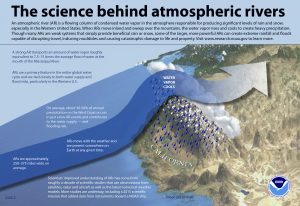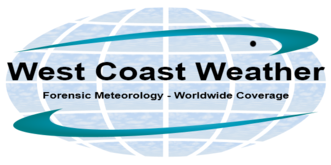Heavy Rain- Atmospheric River
By Michael FaginFlooding, Weather ConditionsWith 0 comments
Heavy Rain- Atmospheric River hits West Coast
The description, Atmospheric River, formerly known as Pineapple Express or the even older, Pineapple Pipeline, refers to the flow of moisture, heavy rain, originating in the sub tropical Pacific Ocean near Hawaii. Flows of this nature are carried in a stream, guided by the Jet Stream and high and low pressure gradients towards the West Coast of the U.S.. Some of these flows have been recorded as carrying as much moisture as the Mississippi River as it enters the Gulf of Mexico.
Heavy Rain Atmospheric River and Snow Melt
As the flow comes ashore, and some of these flows can be 1,000 miles wide, they are affected by the local terrain. More mountainous regions will cause the flow to rise with the moisture being released as snow in the high country and rain, as we are seeing now in California, vast amounts of rain, at lower elevations.
Given existing temperature conditions snow amounts may be measured in feet with rain in the two to four inch range being not at all uncommon. As temperatures rise, and rain begins to fall on the existing snowpack melting can occur at a very fast pace. This meltdown and concurrent runoff will flow downhill rapidly raising the possibility of flooding and further saturating the soils.
Of singular concern are areas that have been recently burned in wildfires where plants, especially native plants adapted to an area, have not had time to take root. Mudslides and landslides in these areas are not uncommon and present a major hazard to people and property in lower lying communities.
Mudslides
While mudslides, landslides and mudflows all share some common characteristics they do in fact, have some significant differences. Land and mud slides are generally local in nature restricted to higher sloped spaces and limited in reach. Not that they cannot be devastating as the Oso Landslide in Washington State proved with homes destroyed and loss of life.
Mudflows are a distinct event. Similar to a volcanic lahar such as occurred with the eruption of Mt St Helens in 1980. These are generally confined to river valleys and will follow the course of same sometimes changing the course of the river itself. Fortunately, events of this magnitude are rare. Mudflows however are a danger given the conditions of saturated soils, steep valley grades and minimal ground cover to slow the flow. Burned over areas are primed for such events in that a mud or landslide may contribute to the flows.
Insurance
Insurance coverage of such events, as is the case with flood insurance, is purchased separately from homeowners insurance. Depending upon local risk factors the cost may be quite high. In many cases such coverage may not be offered by the homeowners policy carrier but must be purchased from another company which specializes in the policies. Your homeowners policy carrier should be able to direct you to a responsible carrier in the event that such coverage is not offered by them.
Litigation in such cases is usually long and very expensive. If a claim is denied by the carrier most insurance carriers have mandatory arbitration clauses before litigation is allowed. In instances where, as has been claimed by the survivors of the Oso, Washington slide, improper or even illegal logging and negligent permitting of logging above the slide site has been claimed. This has been vigorously denied on the part of the state and the logging company. It to date, remains unresolved.
Written by Robert Morthorst and edited by Michael Fagin
